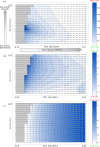Widespread convergence towards functional optimization in the lower jaws of crocodile-line archosaurs
- PMID: 39163982
- PMCID: PMC11335402
- DOI: 10.1098/rspb.2024.0720
Widespread convergence towards functional optimization in the lower jaws of crocodile-line archosaurs
Abstract
Extant crocodilian jaws are subject to functional demands induced by feeding and hydrodynamics. However, the morphological and ecological diversity of extinct crocodile-line archosaurs is far greater than that of living crocodilians, featuring repeated convergence towards disparate ecologies including armoured herbivores, terrestrial macropredators and fully marine forms. Crocodile-line archosaurs, therefore, present a fascinating case study for morphological and functional divergence and convergence within a clade across a wide range of ecological scenarios. Here, we build performance landscapes of two-dimensional theoretical jaw shapes to investigate the influence of strength, speed and hydrodynamics in the morphological evolution of crocodile-line archosaur jaws, and test whether ecologically convergent lineages evolved similarly optimal jaw function. Most of the 243 sampled jaw morphologies occupy optimized regions of theoretical morphospace for either rotational efficiency, resistance to Von Mises stress, hydrodynamic efficiency or a trade-off between multiple functions, though some seemingly viable shapes remain unrealized. Jaw speed is optimized only in a narrow region of morphospace whereas many shapes possess optimal jaw strength, which may act as a minimum boundary rather than a strong driver for most taxa. This study highlights the usefulness of theoretical morphology in assessing functional optimality, and for investigating form-function relationships in diverse clades.
Keywords: Crocodylomorpha; Crurotarsi; biomechanics; functional landscape; optimality.
Conflict of interest statement
We declare we have no competing interests.
Figures




References
-
- Seilacher A. 1991. Self-organizing mechanisms in morphogenesis and evolution. In Constructional morphology and evolution, pp. 251–271. Heidelberg, Germany: Springer International Publishing.
-
- Wilberg EW. 2017. Investigating patterns of crocodyliform cranial disparity through the Mesozoic and Cenozoic. Zool. J. Linn. Soc. 181 , 189–208. (10.1093/zoolinnean/zlw027) - DOI
-
- Martin S. 2008. Global diversity of crocodiles (Crocodilia, Reptilia) in freshwater. Hydrobiologia 595 , 587–591. (10.1007/s10750-007-9030-4) - DOI
MeSH terms
Grants and funding
LinkOut - more resources
Full Text Sources

